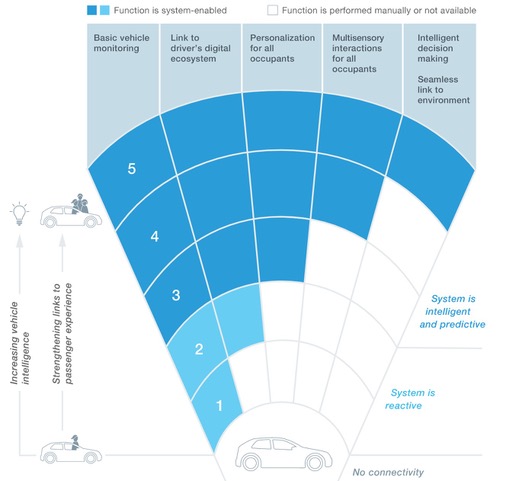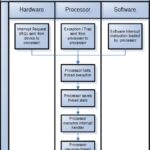Several efforts are underway to define levels of vehicle connectivity that parallel the levels of driving automation defined by the Society of Automotive Engineers (SAE). The concept of autonomous vehicles, particularly at the higher levels of automation like self-driving cars, is still largely aspirational and a goal for some time in the future. Connectivity, on the other hand, is widely available and brings practical benefits to car makers, drivers, and passengers alike. For car makers it can provide access to additional revenue streams, making it of more immediate importance compared with autonomous vehicles.
Addressing concerns related to safety, security, and privacy in connected vehicles is expected to support future deployments of increasingly capable autonomous vehicles. This FAQ reviews two of the efforts to define vehicle connectivity levels and looks at the implications of the levels of vehicle connectivity related to security and privacy, presents exemplary applications for each level, and closes with a look at a proposed Social Internet of Vehicles (SIoV).
Level 0 is defined as no connectivity and is almost non-existent in today’s cars. The five practical connectivity levels are; Level 1 local connectivity only, Level 2 indirect connectivity through connected devices, Level 3 direct connectivity to vehicle OEM only services, Level 4 direct connectivity to OEM services inside and outside of the vehicle, including with the personal devices of users, Level 5 direct connectivity with the vehicle serving as a hub supporting and communicating with several third party services inside and outside the vehicle, including other vehicles and infrastructure (V2X).
It has been estimated by McKinsey that vehicle connectivity and the resulting services it will support could result in incremental revenue of up to $750 billion annually for global car makers. Accessing that potential revenue stream will require some new approaches to connectivity. It will begin with the in-vehicle infotainment (IVI) system for the needed connectivity and extend throughout the vehicle to various electronic systems and sensors (for more insights into IVIs, check out the FAQ, “How do MCUs Support Automotive Infotainment Systems?”).
Autonomous vs connected
Autonomous vehicles and connected vehicles both have implications for safety, security, and privacy. Connected vehicles are a more developed technology. While there are no highly automated (Level 3+) autonomous vehicles commercially available, Level 3 and above-connected platforms comprise most of today’s production vehicles. Several organizations including Privacy4Cars and McKinsey & Company have proposed definitions for the five levels of vehicle connectivity.
Getting users to consent to share data is foundational to monetizing vehicle connectivity. The system must satisfy the requirements of diverse regulations ranging from Europe’s General Data Protection Regulation (GDPR) to the California Consumer Privacy Act (CCPA). Security and privacy are key concerns, and so is gaining specific agreements from individual users for accessing and using data. That has important implications for the implementation of the IVI controller or the telematics control unit. The system should be able to offer users some concrete benefits to elicit agreements for data sharing. Some possible benefits include:
- Reducing vehicle operating costs and improving reliability
- Saving time
- Simpler operation
- Specific improvements in comfort, entertainment, or other aspects of driver and passenger experiences
Increasing levels of connectivity will be able to generate more data and may require different user agreements. Increasing levels of connectivity are also expected to be related to the increasing use of machine learning (ML) in IVI and related systems. That means that the MCUs or system-on-chip (SoC) implementations will need ML functions and ML accelerators in addition to supporting more complex connectivity solutions. Basic definitions of the levels of vehicle connectivity include (Figure 1):
Level 1: vehicle monitoring with wired in-vehicle connectivity, driver able to track basic vehicle usage and monitor status.
Level 2: individual connectivity using wired and wireless networking to external resources, drivers can use personal profiles to customize digital services via external digital ecosystems and platforms.
Level 3: wired and wireless connectivity supports preference-based personalization for all occupants.
Level 4: wired and wireless connectivity with multimodal and multisensory real-time interaction with all occupants including proactive recommendations for services and functions.
Level 5: intelligent decision-making using ML to recognize drivers and passengers and their preferences and provide seamless wired and wireless connectivity access to customized services and functions.

Digging deeper
The basic definitions provide a good starting point, but there’s much more to consider:
Level 1: enables the vehicle to connect to devices in the cabin using protocols like USB or Bluetooth. No connectivity is provided to services outside the vehicle. Applications can include hands-free calling and audio and video streaming. At this level, data does not leave the vehicle and data synchronization is a more important consideration than privacy.
Level 2: the vehicle does not have integrated external connectivity capabilities but can link to external sources through the IVI system using the connectivity provided by devices like smartphones. Privacy concerns are increased since service providers (usually limited to the vehicle OEM) can access information about the occupants or vehicle. Data may be stored on the vehicle that could be accessed by third parties such as service personnel or future vehicle owners.
Level 3: direct connectivity to the vehicle usually through the IVI system. Services are expanded to include automated emergency calling, anti-theft, limited over-the-air (OTA) updates, and so on. Services are limited to the vehicle maker. Data can be always accessed, even if there is no other device like a smartphone connected to the vehicle systems. Data stored on the vehicle can be exposed to unintended third parties and requires higher levels of security to ensure privacy.
Level 4: like Level 3 with direct connectivity to the vehicle. Available services are expanded to include more comprehensive OTA updates and functions offered by independent third parties that have specific authorization from the vehicle OEM. Data is stored on the vehicle, with the vehicle OEM and potentially with third parties. The addition of third parties significantly increases the potential threat vectors and requires more rigorous security and higher levels of privacy protection.
Level 5: the vehicle becomes a hub for communicating with multiple third-party service providers including other vehicles and infrastructure. Communications are no longer strictly limited by the vehicle OEM. Applications extend to outside services like automated parking payments, media sharing, remote security, vehicle-to-vehicle connectivity, and some aspects of automated driving. The vehicle maker and related service parties can still capture most of the data, but unaffiliated third parties also have access to data. This larger and more diverse group greatly increases the complexities associated with satisfying the requirements of GDPR, CCPA, and other privacy regulations. It also increases the number of threat vectors that must be addressed. The wide range of available data in fully connected vehicles increases the potential severity of security breaches including safety concerns for drivers and passengers (Figure 2).

Social Internet of Vehicles
A correlated development with higher levels of vehicle connectivity is the emergence of the Social Internet of Vehicles (SIoV) as a spin-off from conventional vehicular ad hoc networks (VANETs). It uses vehicles connected to other vehicles and smart objects to create a dispersed multi-sensor platform including social networks. Deployment of the SIoV will include autonomous communications between vehicles and smart objects sometimes without intervention or knowledge of the driver or passengers. The SIoV will build on an in-vehicle social network consisting of the passengers and driver, linked to a VANET of surrounding vehicles and infrastructure, and ultimately linked through the cloud to the broader Internet (Figure 3). The ephemeral nature of the SIoV makes ensuring security and protecting privacy very challenging.

Like autonomous vehicles, the development of the SIoV is still aspirational and a large gap exists between the need for robust trust-based communication and existing solutions. A possible approach using a new communications architecture called Trust-Aware Communication Architecture for Social Internet of veHIcles (TACASHI) has been proposed in a recent article in the IEEE Internet of Things Journal. As envisioned, TACASHI also offers a secure and lightweight in-vehicle communication strategy.
Summary
Vehicle connectivity is a well-advanced area of automotive design. It’s defined as a series of increasingly capable levels from 1 to 5, with each succeeding level offering more and more services and presenting greater challenges related to security and data privacy for drivers and passengers. Vehicle connectivity is also contributing to other developments related to the SIoV and VANETs.
References
Connected Vehicle Trade Association
Five Levels of Vehicle Connectivity, Privacy4Cars
How to Monetize Car Data – 3 Strategies for Companies and 28 Practical Use Cases, Grape Up
It’s Time to Rethink Levels of Automation for Self-Driving Vehicles, IEEE Technology, and Society
Setting the framework for car connectivity and user experience, McKinsey & Company
Trust-Aware Communication Architecture for Social Internet of Vehicles, IEEE Internet of Things Journal




